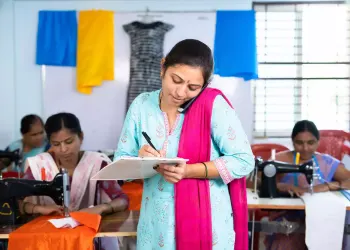
Improved credit access to women's is good news for the Indian economy!
The growing contribution of women entrepreneurs in India’s economy is heartening to witness. Promoting ‘Nari Shakti’ or women empowerment has always been a priority for the Indian government. In a written statement to the Lok Sabha in December 2022, the Union MSME Minister Narayan Rane mentioned that the registration of women-owned Micro, Small and Medium Enterprises (MSMEs) had increased to more than 86% in the FY 2022 from 75% in FY 2021.
The number of women entrepreneurs registered in the ease-of-doing-business Udyam Registration portal for MSMEs increased to 9,10,973 by the end of FY 2022 as compared to 4,89,470 in FY 2021. The Indian government has also taken measures under the Emergency Credit Line Guaranteed Scheme (ECLGS) to provide INR 5 Lakh Crores as collateral-free automatic loans for MSMEs and other businesses. While government-led programs have given more women entrepreneurs in India the impetus to come forward and contribute to the economy’s growth, it does not take away from the fact that women comprise only 20.3% compared to a staggering 79.63% of male-owned MSMEs in the country.
What’s more, despite the drop in the gender gap in bank account ownership from 22% points to nearly zero since 2011, this progress has not translated into increased access to credit for women in India.
The Gendered Credit Gap
The lending ecosystem is marred by a systemic gender gap in accessing credit, resulting in a staggering $158 billion financing gap for women-led businesses. A 2022 report by the International Finance Corporation estimates an $11.4 billion (INR 836 billion) credit demand by women-owned Very Small Enterprises (WVSEs) was largely unmet. Notably, this report also stated that nearly 90% of women entrepreneurs have never had access to formal credit.
It is also interesting to note that the proportion of Indians availing credit is lower than in other developing nations. A 2021 Global Findex Index report found that only 13% of adults accessed formal credit in 2020 compared to 23% of adults in other developing nations, out of which women borrowers in India accounted for only 10% compared to 15% for men.
The ramifications of these credit trends can be seen in the fact that 72% of women-led businesses were cash-strapped during the COVID-19 lockdown. Interestingly, data from the National Sample Survey’s 73rd round shows that while there was an almost equal representation of men and women entrepreneurs in terms of loan access, there was a 50% disparity in the amount of loan borrowed.
Additionally, data from the Mudra Yojana reveals that while 68% of loans were extended to women entrepreneurs under the scheme, 88% of the loans fell under the Shishu category, which is limited to Rs. 50,000.
The recent pandemic has brought to light the systemic gender gap in the Indian lending landscape, with women accounting for nearly 52% of job losses. According to the Mastercard Index of Women Entrepreneurs 2021, India continues to rank amongst the worst-performing countries in terms of the proportion of women-led businesses. It is, therefore, imperative to give a fillip to women’s entrepreneurship.
Social Constraints
Women in India still lag behind their male counterparts in the proportion of transfer of property titles, making it harder for women to access credit on their own property as collateral. Additionally, as per NSSO’s 2019 survey, Indian women spend over 5 hours per day doing unpaid care work, leaving barely any time to network and diversify their sales channels. As a result, women entrepreneurs are considered high-risk by financial lenders.
Shortchanged by Lenders
According to a 2020 Review of Agrigarian Study, Indian women entrepreneurs receive only a 27% credit equivalent of their bank deposits, compared to the 52% received by men. This disparity is further highlighted by the fact that 79% of women-owned businesses were self-financed, as banks remain uncertain about the viability of women-led businesses. Despite data corroborating that women are disciplined borrowers with superior asset quality profiles and low delinquency rates, credit penetration for women in FY 21 remains at 12%.
Underrepresentation of Women in Banking
Traditionally, the banking sector has been dominated by men, causing it to remain unversed in managing the specific needs of female entrepreneurs. Moreover, less than 10% of banking correspondents in India are women, creating a broader gap in women’s access to credit. Government efforts are underway to triple the number of women correspondents in the banking sector by 2025, as they are better equipped to understand the operational constraints that women-owned enterprises function under and extend better advisory and awareness services.
Lack of Aid and Awareness
A lack of awareness and support in non-financial areas further exacerbates the alienation of women from formal credit services. With limited financial literacy, low credit scores, inadequate accounting abilities, and a dearth of tax-filing assistance, female entrepreneurs struggle to navigate the lending landscape.
Mismatched Financial Offerings
Indian women entrepreneurs are subject to rejection rates of 19% compared to a mere 8% for men, resulting in a staggering 70.37% credit gap for women-led MSMEs. Additionally, the paucity of credit options tailored to the needs of women-led businesses represents a significant obstacle for female entrepreneurs.
Owing to suboptimal credit records and documentation, women are frequently subject to exorbitant interest rates and securing a loan is often arduous and replete with collateral demands. Furthermore, biases such as a perception of higher risk, inadequate compliance, and lack of business growth aspirations further exacerbate women entrepreneurs’ difficulties.
Female Entrepreneurs Drive Progress
Despite myriad challenges and barriers, women entrepreneurs in India are leading the way and inspiring more women to start their own ventures. As per a BCG finding, women-founded companies perform better, generate 10% higher cumulative returns over five years, and employ 3x more women, thus being more gender inclusive.
Presently, women-led businesses employ 23% of the country’s workforce, and as the growth of women-owned MSMEs is projected to soar by 90% in the coming years, it is crucial to provide them with ample credit and support to aid in their expansion. By increasing the number of women in the workforce, India can potentially add $700 billion to the global GDP by 2025.
Access to timely and sufficient financing is crucial to the success of any business, particularly those led by women. Financial institutions can empower self-starters and promote financial inclusion by providing better credit access for female entrepreneurs, ultimately benefiting the Indian economy.
Source / Credits / Reference: Times of IndiaRef URL: https://bit.ly/3y3AC30
Back to blogs
Blog Views : 473 02-03-2023

